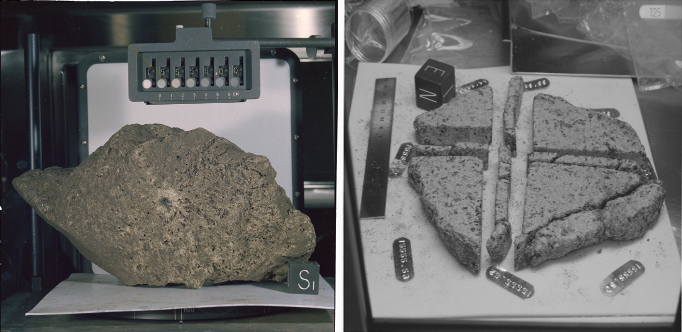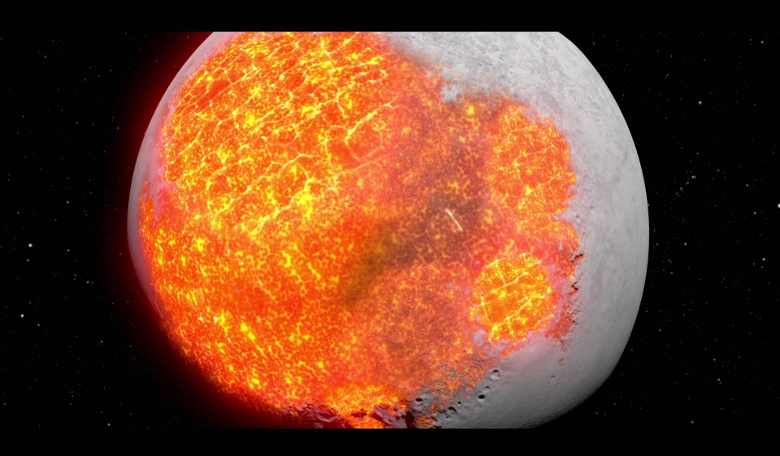By ‘unlocking’ information in volcanic Moon rocks with a state-of-the art 3D mapping technique, an international team of scientists might soon be able to determine how the Moon was formed.
It has been nearly 50 years since the crew of the Apollo 12 mission returned to Earth with a crate of rocks plucked from the lunar surface, but despite the intervening decades of study there is a lot that is still unknown about the Moon’s volcanic history and how this turbulent and fiery period helped its formation.
On Earth, scientists study the inner workings of volcanoes by analysing the minerals contained in the fine-grained rock that is formed from the rapid cooling of magnesium-rich and iron-rich lava; basalt.
More than 90 percent of all volcanic rock on Earth is basalt and around 16 percent of the lunar surface – the dark patches known as Mares, which is Latin for sea – are also covered with the same material. It was once believed that these dark ‘seas’ on the Moon were filled with fresh, young rocks, but the samples returned by the Apollo astronauts showed that they are in fact nearly 3 billion years old.
However, age alone is not going to provide an understanding of the Moon’s primordial volcanic systems. So, in addition to rock dating, researchers have turned to a novel imaging technique that involves bouncing X-rays off a common green mineral – olivine – found in the Moon rock samples to study them in greater detail than ever before.
Olivine in magma is mainly made up of magnesium and iron and as the magma cools, the ratio of these two elements changes over timeframes ranging from hours to months. These changes are ‘locked in’ to the mineral, but the X-ray speckle imaging technique, developed at Diamond Light Source, Harwell, UK, can ‘unlock’ this information by producing 3D images which are then mapped to reveal the history of individual crystals of olivine.
Dr. Matt Pankhurst of Instituto Volcanológico de Canarias and NASA lunar principle investigator explains; “With this new technique, our team may be able to recover from these Moon rock samples information such as what the patterns of magma flow within the volcanic system were, what the magma storage duration was like, and potentially even identify eruption triggers.”
This new research is a long-time coming, because although NASA has had the rocks for nearly half a century now, preserving them has taken priority over analysing them with techniques usually reserved for Earth rocks; that are not only more plentiful, but are a lot easier to reach. These Moon rock samples on the other hand are so precious they are normally kept in a clean environment in a special building called the Lunar Sample Laboratory Facility at the agency’s Johnson Space Center (JSC) in Houston and do not often see the light of day.
Nonetheless, NASA has approved the use of 18 lunar samples to be analysed at the synchrotron facility in the UK, the results of which will not only help reveal the history of the Moon, but can also help to understand active geological processes here on Earth.
“We know that, on Earth, volcanic eruptions can be triggered (or ended) by changes in magma (molten rock) in or beneath the planet’s crust. The cause of these changes is often thought to be a result of the mixing of different batches of magma in the ‘plumbing system’ below the volcanoes. Volcanologists are working on detecting and understanding these changes, by examining volcanic rock samples, with the aim of being able to accurately forecast future eruptions,” said Pankhurst.
 Authentic Moon rock samples being analysed by Dr. Matt Pankhurst of Instituto Volcanológico de Canaries to test the Moon's evolution theory. Image: Diamond Light Source, UK
Authentic Moon rock samples being analysed by Dr. Matt Pankhurst of Instituto Volcanológico de Canaries to test the Moon's evolution theory. Image: Diamond Light Source, UK











